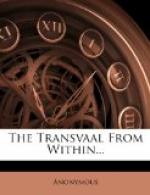In dealing with President Kruger’s personal attitude it is not perhaps pertinent but, it is interesting, to recall an incident of his earlier career—a parallel between the prisoner and the President. Oddly enough President Kruger was a rebel and a filibuster himself in the days of his hot youth, and one of his earliest diplomatic successes was in securing the release and pardon of men who, in 1857, stood in exactly the same position as the Uitlanders whom he imprisoned.
The story of the Potchefstroom revolt is little known in England, but it is told in Theal’s ‘Standard History of South Africa,’ and very instructive reading it is. Dr. Hillier, of Johannesburg, one of the Reformers, called attention just before the outbreak to the extraordinary parallel between the revolt of Potchefstroom in 1857 against the dominance of Lydenburg and the condition of Johannesburg in 1895 under the despotism of Pretoria. Dr. Hillier in his pamphlet said:
In 1857 the Republic north of the Vaal attained its twentieth year. It had increased in population, and had taken on, to some extent, the habits and mode of life of a settled community. Mr. Pretorius and his followers began to feel that in the altered circumstances of the State the time had arrived for a remodelling of the Constitution. Among these followers of Pretorius, these advocates of reform, it is interesting to find was Mr. Stephanus Johannes Paulus Kruger.
Mr. Theal says:
’During the months of September and October, 1856, Commandant-General M. W. Pretorius made a tour through the districts of Rutsenburg, Pretoria and Potchefstroom, and called public meetings at all the centres of population. At these meetings there was an expression by a large majority in favour of immediate adoption of a Constitution which should provide for an efficient Government and an independent Church.’
And again, later on, we have in the words of South Africa’s historian the gist of the complaint against the then existing state of things:
’The community of Lydenburg was accused of attempting to domineer over the whole country, without any other right to preeminence than that of being composed of the earliest inhabitants, a right which it had forfeited by its opposition to the general weal.’
Such was the shocking state of things in this country in 1856. It was a great deal too bad for such champion reformers as Mr. Pretorius and his lieutenant, Mr. S.J.P. Kruger, as we shall see later. Shortly after these meetings were held, a Representative Assembly, consisting of twenty-four members, one for each field-cornetcy, was elected for the special purpose of framing a Constitution and installing the officials whom it should decide to appoint.




